2002 Polaris 700 Twin Series
| First Ride
The Biggest 2002 Polaris |
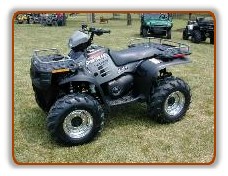 |
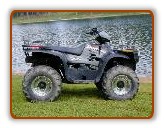 contender. The latest 2002 addition to the Polaris family is the Sportsman 700 Twin. This is the largest utility ATV available, offering comfort, ground clearance and oodles of power. Polaris now has 22 different ATVs in its 2002 model year. The ingenious engineers at Polaris realized the original low emission 700 engine designed for their four-stroke Frontier snowmobile could be easily transformed into an ATV application. With the adjustments in gearing and the switch to tires instead of a track, the Polaris team has fabricated one impressive big bore. Like all manufacturers, Polaris hopes the design of the 700 Twin increases dealer traffic and boosts sales.
contender. The latest 2002 addition to the Polaris family is the Sportsman 700 Twin. This is the largest utility ATV available, offering comfort, ground clearance and oodles of power. Polaris now has 22 different ATVs in its 2002 model year. The ingenious engineers at Polaris realized the original low emission 700 engine designed for their four-stroke Frontier snowmobile could be easily transformed into an ATV application. With the adjustments in gearing and the switch to tires instead of a track, the Polaris team has fabricated one impressive big bore. Like all manufacturers, Polaris hopes the design of the 700 Twin increases dealer traffic and boosts sales.
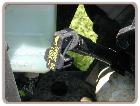
Engine
The Sportsman is definitely at the top of its game; no other single model in any line-up has such a variety of machine sizes to offer. The new 700 Twin, 500HO, 400 and the 90 youth model are all included in this Sportsman line.The new 700 twin-engine was 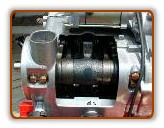
This design keeps the engine compact and full of power. The 683cc. liquid-cooled engine uses a single 34mm carburetor and a single “Y” pipe exhaust. This is a high-pressure oil system using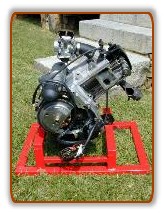
Transmission/4WD
The Polaris Sportsman has a hot new engine with an equally impressive drive train. Transferring the power to the wheels is a 
The Polaris fleet has many improvements. The new Sportsman includes a start in any gear feature and the four-wheel drive system has undergone a major overhaul. The true 4×4 system remains thumb activated and engages when the back wheels lose
Polaris redesigned the shift pattern giving the unit an automotive style parking feature as well as a turnkey starting. Improving on the old “H” shifting pattern, the gears are in a straight-line 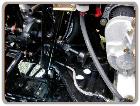
Balancing Quality, Weight and Comfort The Sportsman tips the scales at 740 pounds dry weight (one hundred pounds heavier than other big bore models). An effort was made to keep the weight down, but with demand for larger engines also comes the need to increase the strength of each component. Some contributing factors to the added weight are the frame’s rigidity and quality floorboards. Also, Polaris has decided to include aggressive, high quality tires, Goodyear
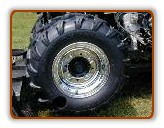 Rawhide Grips (25×8-12 front and 25×11-12 rear) with chrome steel wheels. Polaris did not stop there, a larger 30 amp-hour, 300 cold crank battery was added along with a watercraft type starter. Completing the electrical system is a 300-watt alternator with marine style wire connectors. A larger radiator and electric fan were added, along with an air-bleeding nipple just off the engine. The large bumpers, racks with rails and a towing capacity of 1500 pounds put this ahead of its competitors.
Rawhide Grips (25×8-12 front and 25×11-12 rear) with chrome steel wheels. Polaris did not stop there, a larger 30 amp-hour, 300 cold crank battery was added along with a watercraft type starter. Completing the electrical system is a 300-watt alternator with marine style wire connectors. A larger radiator and electric fan were added, along with an air-bleeding nipple just off the engine. The large bumpers, racks with rails and a towing capacity of 1500 pounds put this ahead of its competitors.
Automatics have always had trouble with freewheeling down hills. The Polaris EBS has sufficient engine braking capability, but when a few hundred pounds are added to the unit engine, braking could be reduced substantially. Another reason why weight cannot be a deciding factor in these large machines is that it takes large braking components to stop big machines with large loads. Polaris 
